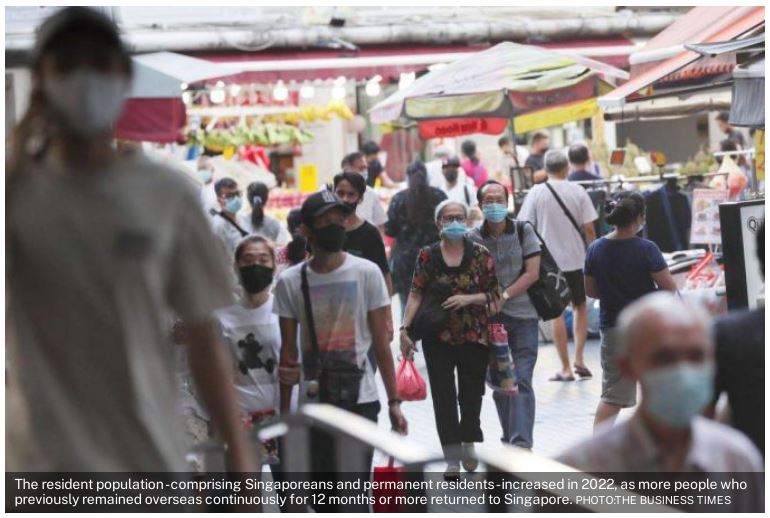Singapore’s population grows 3.4% to 5.64 million, reversing 2 consecutive years of decline
THE total population of Singapore grew by 3.4 per cent over the past year to reach 5.64 million in June, with the easing of pandemic safety measures and travel curbs, the government’s annual Population in Brief report revealed on Tuesday (Sep 27).
The growth reversed two consecutive years of population decline, but the figure remained slightly below the 5.7 million recorded in 2019, pre-Covid-19.
Fewer pandemic health restrictions also had an effect on citizen marriages, which increased by 20.6 per cent to 23,433 in 2021, from 19,430 in 2020.
More people tied the knot in 2021 than in 2019, when 22,165 marriages were recorded, said the report by the National Population and Talent Division.
There were 31,713 citizen births in 2021, a slight decrease from the 31,816 in 2020. The resident total fertility rate recovered slightly to 1.12 births per woman in 2021 from the historic low of 1.1 in 2020. The figure for 2019 was 1.14.
The total fertility rate has been dropping for the past few decades, noted the report, largely due to the rising proportion of people who are single, as well as couples marrying later in life and having fewer children.
From 2017 to 2021, citizen births averaged 32,200 per year, marking a drop from the 2012 -2016 average of 32,900.
This was due to fewer births in 2020 and 2021, partly as a result of delays in marriage and childbearing plans arising from Covid-19 uncertainties, said the report.
The resident population – comprising Singaporeans and permanent residents – increased in 2022, as more people who previously remained overseas continuously for 12 months or more returned to Singapore.
The number of citizens increased by 1.6 per cent, from 3.5 million in June 2021 to 3.55 million in June. For PRs, the increase was 6.3 per cent over the same period, from 0.49 million to 0.52 million.
The non-resident population stood at 1.56 million in June, an increase of 6.6 per cent from 2021. There were 1.68 million non-residents in 2019.
This increase was mainly due to a recovery in foreign employment levels, with the largest increase coming from work permit holders in the construction, marine shipyard, and process sectors.
Singapore’s total population had fallen for the second straight year in 2021, down to 5.45 million from 5.69 million in 2020. This 4.1 per cent decrease was the largest year-on-year decline since 1950.
The pace of immigration continues to be “measured and stable”, said the report.
In 2021, 21,537 people were granted citizenship and 33,435 others were granted permanent residency. This was up from the 21,085 people granted citizenship and the 27,470 granted permanent residency in 2020.
About 6 per cent of the new citizens, or 1,240 of them, were children born overseas to Singaporean parents, or citizens by descent.
These figures were higher compared with 2020 due to easing of travel restrictions and safe management measures, which previously slowed down the processes for the granting of citizenship or permanent residency that had to be done in person.
Singapore’s citizen population also continued to age in 2022, with 18.4 per cent aged 65 and above, compared with 17.6 per cent in 2021 and 11.1 per cent in 2012.
By 2030, around one in four citizens – or 23.8 per cent – will be aged 65 and above. The proportion of the citizen population in this age group is growing at a faster pace compared to the last decade, said the report. THE STRAITS TIMES


 Thailand
Thailand




